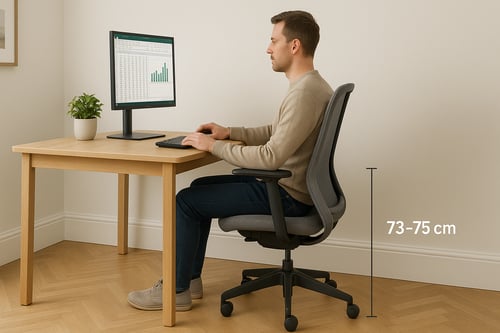Optimal desk height profoundly influences workplace comfort, productivity outcomes, and long-term health considerations. Comprehending appropriate height specifications facilitates informed purchasing decisions that mitigate musculoskeletal complications while enhancing occupational performance. Modern workspace design increasingly prioritises ergonomic principles that accommodate diverse body proportions.
Why desk height matters more than you think
Desk height substantially affects daily occupational experiences through its direct impact on posture, comfort levels, and overall physical well-being. Inappropriate height relationships between users and work surfaces frequently contribute to various physical ailments, including cervical strain, shoulder tension, and lumbar discomfort that develop progressively through sustained exposure to suboptimal positioning.
Occupational productivity demonstrates strong correlation with physical comfort during work activities. Appropriate desk height facilitates natural arm positioning, minimises fatigue accumulation, and enables sustained focus on tasks.
What poor desk height does to your posture
Inappropriate desk height generates cascading postural complications that affect multiple physiological systems. Work surfaces positioned excessively high compel shoulder elevation, generating tension within cervical muscles and upper dorsal regions, while simultaneously causing wrist hyperextension during typing activities. Conversely, inadequately low surfaces promote forward head positioning and shoulder protraction as users accommodate toward work materials, straining cervical vertebrae and compressing thoracic musculature.
What is the average desk height – and is it right for everyone?
Average desk height typically measures 28-30 inches (71-76 centimetres) within most commercial environments. This measurement represents a statistical compromise designed to accommodate the majority of users, although individual requirements vary considerably based on anthropometric measurements and occupational tasks. Individual variations in torso dimensions, arm length, and preferred sitting postures indicate that average height desks may not deliver optimal ergonomic performance for specific users.
Standard desk height in the UK – know the numbers
Standard desk height UK specifications typically range from 70-76 centimetres (28-30 inches), conforming to European ergonomic standards and regulations. British workplace legislation emphasizes employer obligations for providing appropriate workstation configurations that prevent occupational musculoskeletal disorders. UK health and safety guidelines advocate workstation evaluations to ensure desk height compatibility with individual users.
Fixed desks vs adjustable desks – key differences
Fixed desk configurations deliver stability and cost-effectiveness while providing limited customisation possibilities. These conventional solutions function adequately for users whose anthropometric measurements align with standard specifications. Adjustable desk systems provide height customisation within predetermined ranges, typically encompassing 10-15 inches of vertical adjustment capability, with electric mechanisms delivering smooth transitions between height settings.
Key differences between desk types include:
- Fixed desks delivering stability and reduced costs while providing limited customisation possibilities
- Adjustable desks, enabling height customisation within predetermined ranges for multiple users
- Electric systems providing smooth height transitions with enhanced operational convenience
- Manual adjustment mechanisms, offering economical alternatives with fundamental functionality
How high should a desk be for you? A quick guide to finding your perfect fit
Determining optimal desk height necessitates individual evaluation considering anthropometric measurements, occupational tasks, and personal preferences. Begin by establishing an appropriate seating position with feet positioned flat on floor and thighs maintaining parallel alignment to ground. Elbows should preserve 90-degree angles when hands contact keyboard surfaces. Height calculations involve measuring from floor to elbow height while seated, subsequently adjusting for keyboard thickness and personal comfort preferences.
Measuring your ideal desk height – step-by-step
Accurate measurement commences with appropriate seating position utilizing your regular work chair. Adjust chair height until thighs maintain parallel alignment to floor with feet positioned flat on ground. Measure distance from floor to elbow bottom while arms hang naturally at sides, then add keyboard thickness to elbow height measurement, typically 1-2 inches depending on keyboard design specifications.
Adjusting your chair and monitor for a better ergonomic setup
Chair adjustment constitutes the foundation of appropriate ergonomic positioning. Seat height should position thighs parallel to floor while maintaining comfortable foot contact with ground, with lumbar support aligned with lower back curvature to preserve spinal alignment. Monitor positioning requires screen top alignment with eye level or slightly below to prevent cervical strain, while maintaining arm's length spacing to reduce visual fatigue.
Essential ergonomic adjustments encompass:
- Chair height positioning thighs parallel to floor with comfortable foot contact
- Monitor screen alignment at eye level or slightly below to prevent cervical strain
- Keyboard placement enabling relaxed shoulder positioning with elbows positioned close to body
- Lumbar support alignment with lower back curvature to maintain spinal positioning
Achieving optimal workspace ergonomics
Successful desk height optimisation synthesises appropriate measurements with individual preferences and occupational requirements. Understanding standard desk height specifications provides foundational information, while personal assessment ensures customised solutions that promote sustained health and productivity outcomes.
Explore more topics:
Author: Dako Furniture Team


